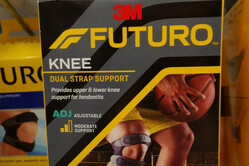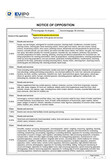


14/06/2018
NEWS STORY
 Unveiled by the sport's new owners at last year's Abu Dhabi Grand Prix as they sought to put further distance between F1 under its new management and the old regime under Bernie Ecclestone, the new logo was intended to "provide a fresh energy for the sport", according to Chase Carey.
Unveiled by the sport's new owners at last year's Abu Dhabi Grand Prix as they sought to put further distance between F1 under its new management and the old regime under Bernie Ecclestone, the new logo was intended to "provide a fresh energy for the sport", according to Chase Carey.
However, just two months later it emerged that the new logo bore a striking resemblance to that being used by manufacturing conglomerate 3M on its Futuro range of therapeutic clothing which includes ankle supports, knee straps and compression tights.
Earlier this week it was revealed that F1 and 3M appear to be on a collision course as the conglomerate filed its opposition to the sport's application for a trademark to its own logo.
While F1 applied for a trademark to its logo in November last year, just weeks before its unveiling, 3M did that for its version nine months earlier and registered it in June 2017.
According to the European Union Intellectual Property Office (EUIPO) the owner of a registered trademark "is entitled to prevent all third parties that do not have his or her consent from using the same or similar signs for identical or related goods and/or services", and it is EUIPO that confirms that 3M registered its logo first.
Formula One's application covers 26 of the 45 categories for which words can be registered in. Those 26 include one for clothing but exclude the one relating to therapeutic clothing for which 3M's mark is registered. However, though the categories are different, this doesn't guarantee F1 protection because the products that the logos are being used on are similar.
In 2008 the European Court of Justice ruled that trademarks are "protected by a basic rule which prevents the registration or use of a sign identical or similar to a registered trademark, for goods or services identical or similar to those for which the mark is registered."
In other words, if an application is made for a logo similar to one which has already been registered it cannot be used on similar products. Now, not only do the two logos look similar, both are to be used on clothing, even if one is leisurewear and the other therapeutic.
Writing in Creative Review earlier this year, Michael Johnson, founder of branding agency Johnson Banks, described the 2008 ruling as "the killer precedent around which 3M's lawyers will be circling their wagons, since both parties wish to sell clothing, and the marks are uncannily similar".
 Crucially, 3M's filing isn't restricted to F1's use of its logo on clothing, but (as shown right) "all the goods and services" because "there exists a likelihood of confusion on the part of the public."
Crucially, 3M's filing isn't restricted to F1's use of its logo on clothing, but (as shown right) "all the goods and services" because "there exists a likelihood of confusion on the part of the public."
In other words, if the EUIPO rules in 3M's favour, F1 would be banned from registering its logo in all of the categories it has applied for including clothing, video games, tickets, sports events and streaming or television coverage of them.
According to Forbes, a decision from the EUIPO usually takes between two to four months and if it upholds the opposition F1 could still appeal. If that failed 3M could then bring trade mark infringement or passing off proceedings if F1 continued to use the logo.
A worst case scenario for F1 would see sponsors and race hosts having to change track signage, ticketing and marketing collateral.
However, F1 could attempt to prevent this by paying 3M which is allowable according to Michael Gardner, partner at law firm Wedlake Bell. "As for whether a negotiated settlement could bring the opposition proceedings to an end. Yes that is perfectly possible. The parties can reach a settlement whenever they like. Provided they both agree, the proceedings would be stopped at that point."
That said, any pay-off of 3M would see the teams hit in terms of the money coming out of the prize pot.
With $30 billion in annual sales, 3M employs 90,000 people worldwide and produces more than 55,000 products, it is also, like most conglomerates, fiercely protective of its trademarks and one has to wonder if the company would be willing to accept a settlement. On the other hand, perhaps a deal might be done whereby the company is seen as an official partner of the sport.
Faced not only with the amount of compensation that might be required but also the loss of face if ordered to change its new logo, it will be a worrying four months for F1 under its new ownership.
According to Forbes, if the EUIPO upholds the opposition and prevents F1 from registering the logo in every category applied for, Liberty would have no option but to fully re-brand or pay whatever 3M wants if it agrees to a settlement.
However, given that 3M's trademark registration for the logo is only in category 10, which covers therapeutic clothing, Michael Gardner is unsure how it could be used as opposition to F1's application in categories which aren't similar.
"It is rather strange to my mind that 3M appear to have filed an opposition to all the goods and services covered by F1's application when 3M are relying only on their registered EU trade mark in class 10 and on sole basis of 'likelihood of confusion'."
However, this doesn't solve the problem for F1 given the importance of branded clothing and the loss of revenue should the current range need to be scrapped. In fact, it might make more sense to bite the bullet and re-brand with a logo which can be used.